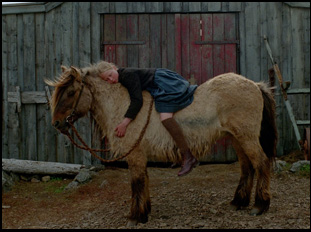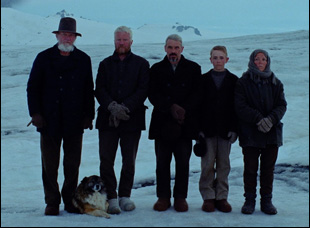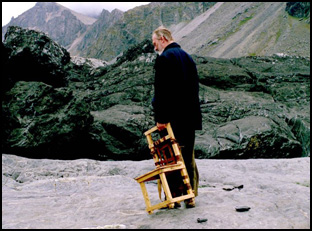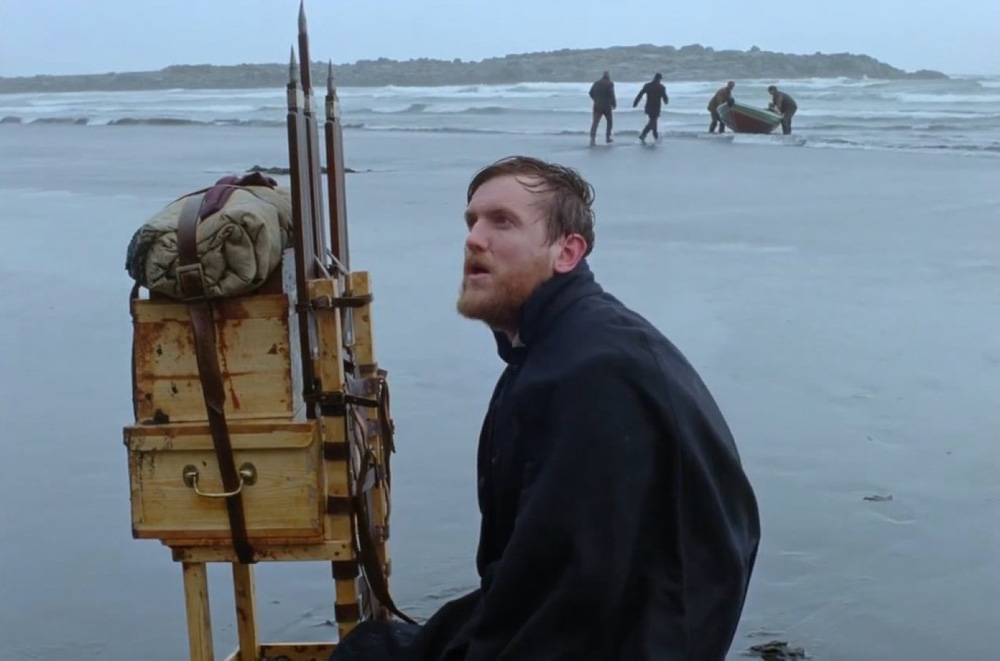When Hlynur Pálmason left film school, he had three scripts in tow – “Winter Brothers,” which he would first work on with the actor Elliott Crosset Hove as one of two siblings to work at a limestone factory where it appears both could be stuck for the rest of their days, “A White, White Day,” which he would film next with Ingvar Sigurdsson starring as a cop who begins to investigate an affair his late wife may have had outside the parameters of his job, and a third, “Godland” that he knew would take some time. The director, who spent a decade of his life in Denmark, but returned to the humble fishing village of Höfn in Iceland where he was born to make movies, has afforded himself that luxury in having actors who are no more than a stone’s throw away show up only a very loose timetable when nature is their set and taking a camera out when the seasons change. (His daughter has become a regular.)
It fits the filmmaker’s sly sense of humor that the film that took him the longest to make, having paid off handsomely as Iceland’s official selection for the Oscars and one of the finest dramas of 2023, centers on a protagonist who believes he has such patience, though he is reminded time and again he does not as a Danish missionary who is dispatched to the furthest reaches of Iceland towards the end of the 1800s with the goal of building a church and converting the locals. Lucas, played by Crosset Hove, has a hard enough time convincing the crew he’s been assigned to lead him there, led by the surly Ragnar (Sigurdsson), to stay the course as the elements clearly aren’t in their favor and the religious mission also has other implications that the Icelandic crew may object to when their language and their culture as a whole threatens to be wiped away if the Danes such as Lucas impose themselves on their land.
Lucas doesn’t only happen to be a man of the cloth, but one who carries a camera along with him, which Pálmason finds to be a most interesting hobby when his staged view of the world will become the historical record while what he actually experiences with all its struggle is bound to be left behind and the writer/director inventively brings these tensions to the surface with title cards in both Danish and Icelandic and announcing upfront that what you’re watching was inspired by actual photos from the time, yet suspicion sets in that no such photos ever existed. There are time-lapse sequences in the film that took over two years to complete, but Pálmason also has built up both a remarkable company of actors and a command over the craft that makes his latest his most accomplished to date, inviting one to sit in awe of untamed land in both its beauty and its capriciousness as well as raising questions about the human impulse to assert authority over it and each other.
Now available on Criterion Channel and a fine new Blu-ray after its release earlier this year, Pálmason kindly revisited the film and spoke about his unique process to make it, not only developing relationships with his cast and crew over years to create such richness but having them form those bonds with one another and enduring a grueling shoot that put him in the shoes of his main character.

I don’t know why it started so early, but it changed form almost every year. The photography element [with] him carrying the camera, came quite late, and that was what triggered my desire to work on it again because at a certain time in the process, as sometimes happens, things become tired or you’re not as interested in it. Often I have a lot of ideas of things I want to do and a lot of characters and stories I want to explore, but the ideas or the narratives also have to have a form that I really that I’m really interested in, and sometimes it takes a while to find the form, so when I figured out that he was carrying a camera and I started to explore the idea of the photos he took and the people he met and the situation he had with them while photographing them, it made everything so much easier and so much joyful. The whole process of writing it became very stimulating, and you’re always hoping for that – some kind of trigger of desire to do it. So I started working on it around 2013, and then I started shooting right after “White, White Day.” I started filming two of the scenes, and that [was] two years before principal photography, so it was a long, strange, mysterious process.
From what I understand, because you and the cast and crew all live in the same area and you film around where you live, a shoot can happen at any time. What’s it like to work with time as you do rather than having some compressed schedule?
I don’t know if it’s a conflict, but it’s a struggle to make films for me [because] I live quite far away from [civilization], on the southeast coast of Iceland, so it’s quite isolated, just outside a very small town. But we found a way to work on a couple of projects at a time, sort of in parallel and it really suits me because then I can write and shoot and work with scenes and ideas every week. I’m not only filming for a period of time, and then three years later, filming again, but I’m constantly filming and trying out things and reacting to the material when we scan and develop the film. I found it very stimulating for me as a filmmaker to be in the process constantly, and I’m not saying that it’s a perfect process. It’s full of conflicts and full of struggle, but it’s fun and it’s creative.
It is really about trying to dive deeper into something and be surprised by the material, like how I feel when I watch a Cassavetes film. I’m always surprised, like I don’t know what direction the film is going, and the dialogue is really fresh and the decisions always seem fresh. I’ve been very inspired by that and trying to figure out a way for me to be free like that. Of course, I’m not Cassavetes, but I’ve been trying to do it my own way and finding my own voice with it.

A lot of the stories are inspired by things I’ve heard or read about the southeast coast of Iceland, but I also read a lot of travel books written about Iceland during that time from all over the country, both English and Danish and French and American, just to get an idea how it was. And then I also read letters, but at a certain time, I felt it was becoming too stiff and it was too much information. So I just let go. This fictional story of these negatives that triggered the desire to make it for me – the wet plate thing was in the beginning of the text – but the idea was never to use it in the film itself. [Then] in the first cut, we decided to have it in the first cut just because it’s there in the script and it worked as a hook to get people into the story. But the film is inspired by a lot of things around my area – the eel story, etc – but they are very fictionalized. They’re mysterious for myself also when I wrote them, and because I’m filming things and then reacting to the things I film and then I write the scenes in between, don’t have a preconceived idea of everything. It happens gradually.
Could the locations you knew of give this shape as a narrative?
Yeah, it was really important for me from very early on to write for certain places that I know. But that’s how I feel about filmmaking [generally]. It’s very important for me to be there and to travel to the locations and see them in different seasons and try to figure out when does this film take place? Is it a winter film? Is it a summer film? Is it a spring film? And what kinds of sounds are there? Are the birds migrating during that time or are they gone? All of these things have a huge effect on the film and and color of it throughout the whole process. I really need that very early on to know what I’m writing for, and even with my characters, I find it really nice to know who I’m writing for, so often I cast the biggest parts in the film very early on. I even talked to Elliott [Crosset Hove], who plays Lucas in 2013, which sounds crazy, but I wrote it for him.
Ingvar Sigurdsson, who plays Ragnar, was also the lead of your last film “A White, White Day.” Do the actors influence the characters as much as you might see them in the roles?
With this film, it was very important for us to shoot it chronologically because it’s a journey, and we wanted to not manipulate too much in this journey, so the audience watching the film really feels the way Lucas is peeled apart. I wanted to be as natural as possible and because [we filmed] chronologically, the actors had some time to figure out who they were and grow into the characters because often I don’t know that much about the characters [at first], so I really can’t help them that much. I have a hard time talking about story background, like where do they come from or why does he do that because it’s quite mysterious for me. I don’t have the answers. But because Ingvar and Elliott are such good friends and I know them so well, we’re exploring it together and trying to figure it out together. I remember Ingvar, for example, being really stressed the first three days of shooting because he had no idea who he was, and he had a lot of [self-]doubt. But I think it’s part of the process to doubt. That just means you care and it matters.

Yeah, it was, and that’s really what I mean. I haven’t done a lot of films, but from the projects that I’ve done, I’ve always felt that like the process itself of making the film really colors the film – the temperament we have on set and the friendships and everything. You can see it in the film. So it was really important for us that we were very small and intimate crew, traveling together and shooting it chronologically, so it was not only the character’s journey, but also the journey of the filmmakers. That felt very natural.
There were difficult days. We had these monsoon rains for the first three or four weeks where it just rained constantly, which fit the film perfectly. We were always soaking wet traveling in the mountains and sometimes we had to move certain areas where you couldn’t drive. You had to go with horses, so a lot of it was a physical film. It would probably be a very expensive film if you made it as a more traditional movie [production], but we were a little bit more rock and roll. It was easy for us to move around and we didn’t have any screens or electronics. We were just carrying our lunch with us, so it was very simple.
Since this was the last of the three films you had specific ideas for after film school, what does it feel like moving on from them and having these all under your belt?
I remember even when we were filming [“Godland”], there was a scene where there’s this physical conflict between Lucas and Ragnar, and I really felt the crossroads like “Okay, this is probably the last physical fight I’ll have for a long time because I really felt that that I didn’t have more of it in me,” so I do feel now that the first three films are done and there is a crossroads now. We are working on something different, and we’ve already started filming the next project for a year now, and it’s definitely different and something else, but hopefully just an extension of what we’ve been doing, hopefully just moving forward and trying out new things. And for me and my crew and cast, it’s always about the next project. When we’re making a film, we’re talking about other projects that we want to make, so it’s always about moving forward. I thought my time with “Godland” was finished because I thought I would just be now shooting my next one, but it’s good to come a little bit back and talk about it. It’s cozy.
“Godland” is now streaming on the Criterion Channel.




